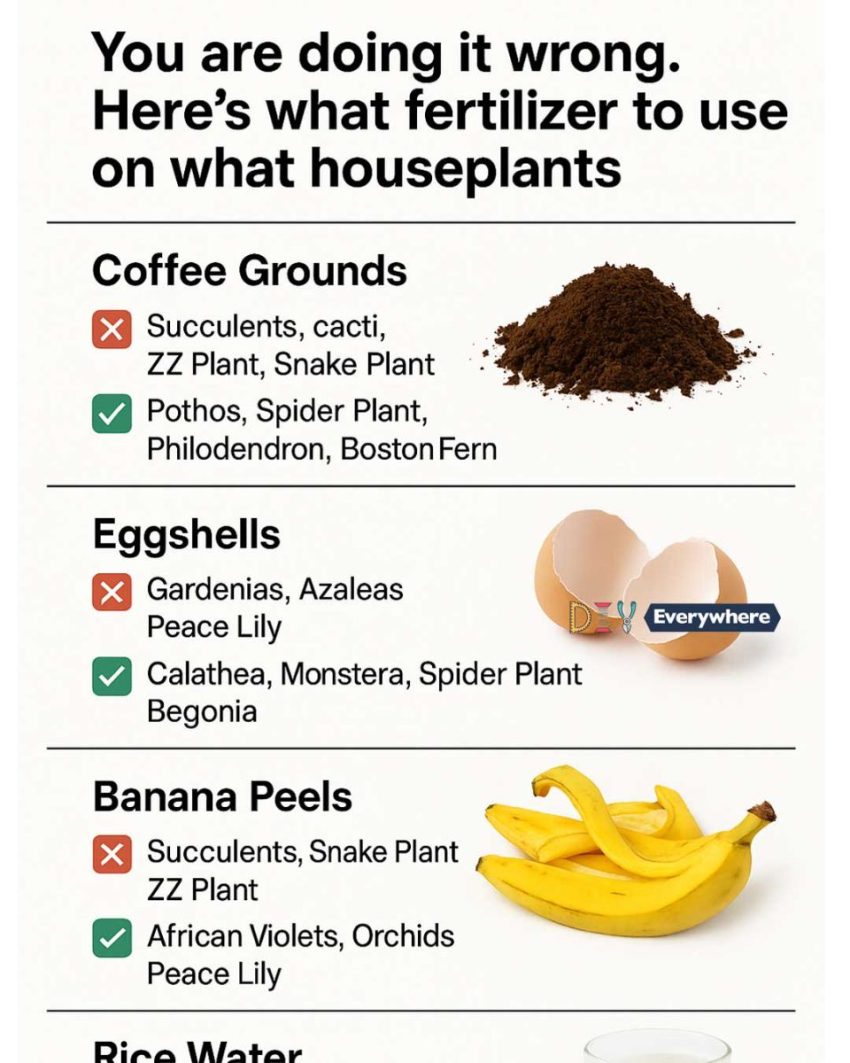ADVERTISEMENT
1. ☕ Coffee Grounds
Why: High in nitrogen, good for foliage growth—but holds moisture.
How to Use: Mix 1 tablespoon of used grounds into 1 cup of compost or potting mix every 4–6 weeks. You can also brew a weak “coffee tea” by soaking 1–2 tablespoons of grounds in 1 quart of water overnight, then strain and water your plants with it once a month.
Best Used On: Pothos, Spider Plant, Philodendron, Boston Fern.
Avoid On: Succulents, cacti, ZZ Plant, Snake Plant—prone to rot in damp soil.
2. 🥚 Eggshells
Why: Add calcium and lower soil acidity.
How to Use: Rinse and dry eggshells, crush into fine powder (coffee grinder works best). Mix 1 tablespoon per plant into topsoil or steep 5–6 crushed shells in 1 quart of water overnight and use the liquid monthly.
Best Used On: Calathea, Monstera, Spider Plant, Begonia, indoor tomato plants.
Avoid On: Gardenias, Azaleas, Peace Lily—these thrive in acidic soil.
3. 🍌 Banana Peels
Why: Rich in potassium and phosphorus for blooms and root health.
How to Use: Chop finely or blend into a puree and mix 1 tablespoon into soil once every 4–6 weeks. Or steep chopped peel in water for 2–3 days, strain, and use as liquid feed.
Best Used On: African Violets, Orchids, Peace Lily, Bird of Paradise.
Avoid On: Succulents, Snake Plant, ZZ Plant—low nutrient needs and rot-prone.
4. 💦 Rice Water
Why: Starch and trace minerals feed soil microbes.
How to Use: Collect water from rinsing or boiling unsalted rice. Let cool and use to water plants once every 1–2 weeks.
Best Used On: Peace Lily, Pilea, Philodendron, Ferns, Spider Plant.
Avoid On: Succulents, cacti, ZZ, Snake Plant—don’t like excess moisture.
5. 🧂 Baking Soda (Diluted)
Why: Natural antifungal that helps treat powdery mildew.
How to Use: Mix 1 teaspoon of baking soda + 1 quart of water + a drop of dish soap. Spray lightly on leaves once a month as a preventative or treatment.
Best Used On: African Violets, Spider Plant, Geraniums, Begonias.
Avoid On: Acid-loving plants like Ferns, Gardenias, Calatheas—can raise pH too much.
6. 🥕 Vegetable Scraps (Compost)
Why: Full-range nutrients for long-term health.
How to Use: Compost kitchen scraps (carrot peels, lettuce ends, etc.) until fully broken down. Mix ½ cup compost into potting mix or use as a top dressing every 6–8 weeks.
Best Used On: Monstera, Fiddle Leaf Fig, indoor tomatoes.
Avoid On: Succulents, cacti, bonsai—can cause overfertilization.
7. 🧅 Onion Skin Tea
Why: Natural source of potassium, calcium, and sulfur.
How to Use: Boil 1 cup of onion skins in 1 quart of water, let steep overnight, cool, and strain. Use once a month as a foliar spray or root drench.
Best Used On: Peace Lily, Bird of Paradise, Orchids.
Avoid On: Ferns, Calatheas—sensitive to strong-smelling fertilizers.
8. 🥔 Potato Water (Unsalted)
Why: High in potassium, supports growth.
How to Use: After boiling potatoes (no salt!), let water cool completely. Use 1 cup per plant every 2–3 weeks.
Best Used On: Pothos, Philodendron, Spider Plant.
Avoid On: Succulents, cacti—too much moisture, and starch can mold.
9. 🌻 Epsom Salt (Magnesium Sulfate)
Why: Helps green up yellowing leaves and supports nutrient absorption.
How to Use: Dissolve 1 tablespoon of Epsom salt in 1 gallon of water. Water plants once every 4–6 weeks.
Best Used On: Fiddle Leaf Fig, Monstera, Peace Lily (if magnesium-deficient).
Avoid On: Plants already thriving in nutrient-rich soil—ZZ, Snake Plant.
10. 🍏 Apple Cider Vinegar (Highly Diluted)
Why: Acidifies alkaline soil; ideal for acid-loving plants.
How to Use: Mix 1 teaspoon of apple cider vinegar in 1 gallon of water. Use once every 4–6 weeks during active growth.
Best Used On: Gardenia, Azalea, Calathea, Ferns.
Avoid On: Succulents, Jade, Spider Plant—can make soil too acidic.


